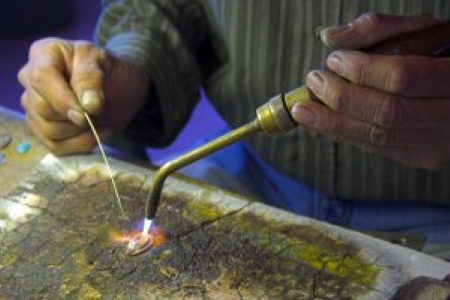Do you work primarily with copper sheet? If copper is the metal of choice for your jewellery designs, and you’re searching for a new approach, why not incorporate silver? Bringing together copper and silver sheet can make your design stand out, with contrasting colours and textures that will set you apart from other designers.
Here’s our beginners’ guide on how to solder copper and silver together using some basic tools and techniques.
Soldering silver to copper:
Many jewellers find learning how to solder copper and silver very tricky, because of their differing melting temperatures. But if you’d like to achieve the unique effect that bright silver against textured copper can give, it’s certainly worth learning more about.
Here are our top 4 tips on how to solder silver to copper:
1. Keep your metal clean
One of the most important things to keep in mind when you’re learning how to solder copper and silver together is to keep your metal as clean as possible. The same goes for your flux too (especially if you tend to use a borax cone, as dust and grime can easily get caught in the borax dish as you work at your bench) So, before you start soldering rinse out your borax dish and pour yourself a new batch of flux to work with.
It’s especially important to keep copper clean as you work because it’s prone to oxidisation and it happens very quickly when you heat the metal. So, after you’ve cut out the relevant design from your copper sheet, give it a quick clean with a brass brush to remove any fingerprints or residue that may have been left behind as you work on cutting out the design.
2. Get to know the melting points of copper and silver
When soldering copper and silver one of the most important things to keep in mind is the different melting temperatures of each metal, especially when you’re soldering together large elements as this can affect the way that you work.
- Melting point of copper: 1085°C
- Melting point of silver: 956°C
As copper has a higher melting point than silver, you do run the risk of melting your silver or having the silver sink into the copper that you’re working with. As you heat the metals, keep a very close eye on your silver. If there is any indication that your silver is becoming molten, make sure you move the flame away from the design before starting the process again. Getting the process right can be a little tricky, but with practice you’ll soon recognise the point at which the solder has done its job, leaving you with a new take on your copper designs.
3. Try sweat soldering
A simple way of soldering together a piece of copper and a piece of silver is to use a technique called sweat soldering. This reduces the risk of heating your piece of silver too much and instead leaves you with a solder joint that is barely visible.
Need to learn the basics of sweat soldering before you get started? Read our guide for beginners on how to sweat solder.
- Prepare your piece of silver for soldering by making sure that it’s clean.
- Now, with a small amount of easy silver solder coated in flux and placed at the very end of some fine tweezers, you can begin to heat it with your hand torch.
- You will have to move quickly, as the silver solder will start to ball up rapidly. As you see it ball up, place it onto the underside of your silver sheet until it flows across the surface.
- Place your silver sheet to one side and apply a small amount of flux to the top side of your copper sheet. Make sure the area that is covered is roughly the same as the size of your silver sheet.
- Once the flux is applied you can place the silver sheet on top of the copper sheet, ensuring that the solder is face down on the copper sheet.
- Now heat the silver sheet in a circular motion until the silver starts to reach annealing temperature or begins to glow a dull cherry red colour.
- Try to use a large enough flame so that you can heat the silver quickly to avoid it sinking into the copper sheet. If you heat with a smaller flame over a longer period, this can create certain oxides that will make it much more difficult for the solder to flow.
- Once the silver has gotten up to temperature, remove the heat and quench, pickle and rinse.
4. Use flux for an accurate solder joint
Remember that the flux will help the solder flow and fix the silver sheet in place. But it’s also worth making sure you continue that circular motion as you heat the silver– the solder will be drawn towards the heat, so this will help it flow where it needs to. The flux will burn off quickly too, so it’s important to remember to work as fast as you can.
Now you know how to solder silver to copper, you can experiment with different designs and styles. And the great thing about working with copper is that you can add varied texture to your pieces too. It’s so simple to hammer or roll a rough texture onto your copper sheet, that the opportunities to come up with new designs are endless!

Cooksongold

